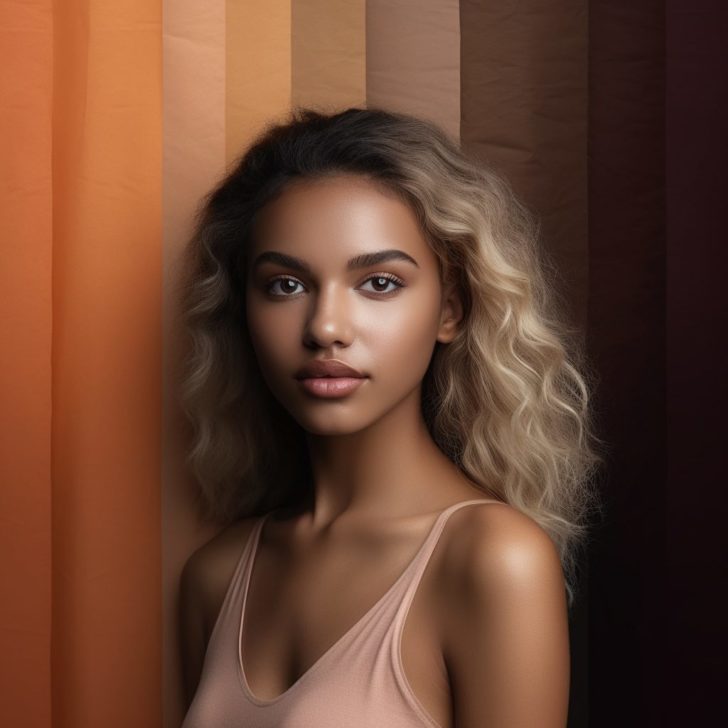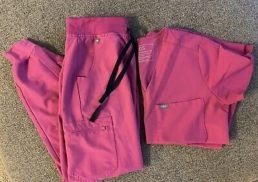Have you ever wondered why certain colors make you look radiant and glowing, while others seem to wash you out? The secret lies in the world of colour analysis, a technique that helps you discover your perfect color season to enhance your natural beauty. In this comprehensive guide, we’ll explore the science behind colour analysis, provide a step-by-step guide to identifying your color season, and offer tips on embracing your season to boost your confidence and personal style.
Table of Contents
Key Takeaways
Understand the role of undertones and three dimensions of color to identify your season.
Assess skin tone, hair colour & eye colour for an accurate analysis.
Utilize DIY tools and resources to build a wardrobe that flatters you!
The Science Behind Colour Analysis

Color analysis is based on the science of how different colors complement an individual’s natural coloring, including skin undertones, hair color, and eye color. At the heart of color analysis lies the concept of seasonal color analysis, which considers the undertones (hue) and the value (light versus dark) of our skin, hair, and eyes, helping in identifying color seasons like:
Soft autumn
Warm spring
Cool summer
Deep winter
Warm colors possess yellow undertones while cool colors present blue undertones. Grasping the differences between warm and cool colors aids in the selection of appropriate color palettes for individuals, for instance, those falling under the soft summer category.
For a comprehensive understanding of color analysis science, the role of undertones and the three dimensions of color – hue, value, and chroma – warrant further exploration.
The Role of Undertones
Undertones significantly influence the determination of an individual’s color season, as warm undertones correlate with yellow or gold and cool undertones align with blue or pink. Identifying one’s cool or warm undertones can be done by examining the veins in the inner wrist. If the veins appear blue or purple, the individual is cool-toned, while if the veins appear green, the individual is warm-toned.
There are several tests to help determine your undertones, such as the jewelry test, which involves placing silver and gold jewelry on your skin in natural sunlight to see which metal complements your skin tone better. Another method is the White Paper Test, which assesses whether you have warm or cool undertones in your skin complexion by comparing it to a white piece of fabric or paper.
Hue, Value, and Chroma
Hue, value, and chroma are the three dimensions of color that help identify the most flattering colors for each person based on their natural coloring. Hue refers to the color itself, value indicates the lightness or darkness of a color, and chroma measures the brightness or greyishness of a color. These dimensions generate six characteristics in the twelve seasons color model, which take into account the interconnectedness of the seasons.
For example, a Clear Winter’s hue leans towards cool, the value is medium, and the chroma is clear and bright. Understanding these dimensions of color allows for a more accurate identification of the colors that best suit your unique coloring, ultimately leading to a wardrobe that embraces your natural beauty.
Identifying Your Color Season: A Step-by-Step Guide

Having delved into the science of color analysis, a practical step-by-step guide to identifying your color season is next on the agenda. This process involves assessing your skin tone, hair color, and eye color to determine the best colors for you.
Begin by taking a face-only selfie and identifying the most prominent tones from your skin, hair, and eyes. The initial element of a color analysis is identifying your undertone. Once you’ve determined your undertone, you can examine your hair color and eye color to further refine your color season.
Skin Tone Assessment
Skin tone assessment includes evaluating your undertone and its relation to your color season. The undertone is vital in pinpointing your color season and aids in discovering the ideal colors for individuals with a variety of hair colors, such as golden brown.
One method to identify your undertone is the fuchsia-versus-orange test, which helps assess whether you have warm or cool undertones. Another reliable method for discovering your seasonal color palette is to perform color draping, which involves comparing various colors to your skin tone to see which ones are the most flattering.
Hair Colour Evaluation
Hair color evaluation helps narrow down your color season by considering the warmth or coolness of your hair color. When evaluating your hair color, it is important to take into account your natural hair color, the tone of your skin, and the color of your eyes. The best way to evaluate your hair color is to observe how different colors appear when worn, as this can give you an indication of whether your hair has warm or cool undertones.
Understanding the warmth or coolness of your hair color can provide valuable insights into your color season and guide you towards the most suitable colors for your wardrobe, makeup, and hair dye choices.
Eye Colour Analysis
Eye color analysis further refines your color season by examining the hue and intensity of your eyes. Different eye colors are linked to specific seasons, and this analysis considers the distinctive qualities of the eyes to guide the color analysis process.
Eye colors range from light blue to dark brown, with each color being associated with a particular season. For instance, light blue eyes are linked to the Spring season, and dark brown eyes are associated with the Autumn season.
By examining your eye color and its relation to the color seasons, you can gain a clearer understanding of which colors will enhance your natural beauty.
The Twelve Color Seasons: Characteristics and Palettes

Armed with an improved understanding of color analysis science and the steps to identify your color season, it’s time to examine the twelve color seasons, their characteristics, and associated color palettes in detail. These seasons are derived from the original four seasons of Winter, Spring, Summer, and Autumn, and are further divided into sub-seasons to accommodate the range of individual coloring.
Each color season has a unique set of colors that complement the natural coloring of individuals with specific undertones and features. By familiarizing yourself with the characteristics and color palettes of these twelve seasons, you can more easily identify your own season and make informed choices when it comes to your wardrobe, makeup, and hair color.
Winters: Cool, Clear, and Deep
Winters are characterized by cool, clear, and deep colors that complement their cool undertones and high contrast features. This can include individuals with cool undertones, medium to dark brown hair with ashy undertones, gray, blue, or slate eyes.
The best colors for Winter are high-saturation colors and rich primary colors, such as white, black, navy, red, icy blue, and hot pink. These colors are not advised for Winters: earthy tones, warm nudes, warm browns, oranges, and yellows. Instead, cooler and more muted tones should be favored. By embracing their cool, clear, and deep colors, Winters can create a striking and harmonious appearance.
Summers: Light, Soft, and Cool
Summers have light, soft, and cool colors that work well with their neutral undertones and delicate features. Individuals with a Summer complexion may have fair skin that may tan or freckle, and golden blonde or brown hair with blue, green, hazel, or light brown eyes.
Summers are recommended to wear cool hues that are medium to dark in tone, such as:
camel
peach
golden-yellow
lime
They should avoid warm tones, earthy shades, and particularly warm yellows, as these colors may not be as flattering. By embracing their light, soft, and cool colors, Summers can achieve an elegant and harmonious look.
Autumns: Warm, Deep, and Soft
Autumns feature warm, deep, and soft colors that enhance their warm undertones and rich coloring. This can include individuals with warm undertones, medium to dark brown hair with golden or red highlights, and medium brown, dark hazel, or dark brown eyes.
The best colors for Autumn are:
Olive green
Rust
Mustard
Burgundy
Autumns should avoid cool or icy colors, as these may not be as flattering. By embracing their warm, deep, and soft colors, Autumns can create an inviting and harmonious appearance.
Springs: Light, Clear, and Warm
Springs are associated with light, clear, and warm colors that suit their warm undertones and bright features. Individuals with a Spring complexion may have fair skin that may tan or freckle, and strawberry blonde or golden brown hair with green, blue, or hazel eyes.
The best colors for Spring are vibrant, energetic colors, such as coral, turquoise, bright yellow, and dark green. Springs should avoid muted or dusty colors, as these may not be as flattering. By embracing their light, clear, and warm colors, Springs can create a lively and radiant appearance.
Embracing Your Season: Tips for Building Your Wardrobe
Having identified your color season, the next step is to embrace it and construct a wardrobe that enhances your natural coloring. Wearing the right colors can significantly enhance your style, makeup, and overall appearance, making you look vibrant, fresh, and energized instead of dull or sallow.
In constructing your wardrobe, consider the following:
Identify pieces that align with your color wheel and coordinate with one another.
Opt for colors that accentuate your natural coloring, such as warm tones for autumns and cool hues for winters.
Add accessories such as jewelry and scarves to add a splash of color to your ensemble.
Shopping for Your Season
Shopping for your season entails choosing clothing and accessories in colors that compliment your color season and steering clear of those that don’t. Use your newfound knowledge of your color season to make informed choices when shopping for clothing, ensuring that each item you purchase aligns with your color wheel and contributes to your overall beauty.
Additionally, seek out retailers and brands that cater to specific color seasons, as they will likely offer a curated selection of items in colors that complement your natural coloring. This will make the process of building your wardrobe more streamlined and efficient, ensuring that you only invest in pieces that truly enhance your appearance.
Makeup and Hair Colour Choices
Makeup and hair color choices should also be based on your color season to create a cohesive and harmonious look. For instance, light brown hair can be complemented by oxblood lipsticks and bronze eyeshadow tones, while blonde hair may be enhanced with pinks, berries, and peaches on the cheeks.
When selecting makeup colors, consider the undertones of your skin, hair, and eyes to determine the most suitable shades. Likewise, when choosing hair dyes, opt for colors that flatter your color season and enhance your natural beauty.
By making informed choices when it comes to makeup and hair color, you can create a polished and cohesive appearance that truly reflects your personal style.
The Impact of Colour Analysis on Confidence and Personal Style
Discovering your color season can have a positive impact on your confidence and personal style, as you learn to wear colors that enhance your natural beauty. No longer will you find yourself struggling to coordinate outfits or feeling lackluster in your appearance; instead, you’ll radiate confidence and style in every ensemble.
By embracing your color season and using it as a guide for selecting clothing, makeup, and hair color, you’ll not only create a harmonious and cohesive look but also boost your self-esteem. When you feel confident and vibrant in your appearance, this energy shines through in all aspects of your life, making color analysis a powerful tool for personal growth.
DIY Colour Analysis Tools and Resources
For those keen to undertake color analysis independently, a range of DIY color analysis tools and resources are available to assist in identifying your color season. Online quizzes, such as the one offered by colorwise.me, can provide a quick and easy assessment of your seasonal color type.
Smartphone apps, like My Best Colors, use your smartphone camera to identify colors that are flattering to you, making it a convenient shopping companion. You can also seek expert advice on platforms like Fiverr.com, where experienced stylists can assist you with color analysis and offer personalized guidance on building your wardrobe.
With these resources at your fingertips, you’ll be well on your way to discovering your perfect color season and embracing a more confident and stylish you.
Check out Do-It-Yourself Colour Analysis Options.
Summary
In conclusion, color analysis is a powerful tool that can help you discover your perfect color season, ultimately leading to a more confident and stylish appearance. By understanding the science behind color analysis and following the step-by-step guide to identifying your color season, you can build a wardrobe that enhances your natural beauty and showcases your personal style. So why not embark on this colorful journey today and uncover the power of color in transforming your confidence and personal style?
Frequently Asked Questions
How do I know my color analysis?
By looking at the veins in your inner wrist, you can determine if you are cool or warm toned. If your veins appear mostly blue or purple, you are cool-toned, while green veins indicate a warm tone. This test can be useful for many, however it is important to note that not everyone will have clearly visible vein colors.
Is Colour analysis legit?
Although beauty is subjective, colour analysis can be a helpful tool in finding the most flattering colours for your skin tone. By investing in color analysis, you could save yourself time and money when selecting clothing and make-up in the future.
How does a color analysis work?
A color analysis works by examining the hue, value, and chroma of your skin, eyes, and hair to determine your seasonal color palette and dominant. This helps you identify which colors suit you best.
Can I still wear my favorite colors even if they don’t belong to my color season?
Yes, you can still wear your favorite colors, but incorporate more from your color season for a more balanced look.
What are some methods to determine my undertones?
Examining your veins in your inner wrist, performing the Jewelry Test, and using the White Paper Test are some methods you can use to determine your undertones.









